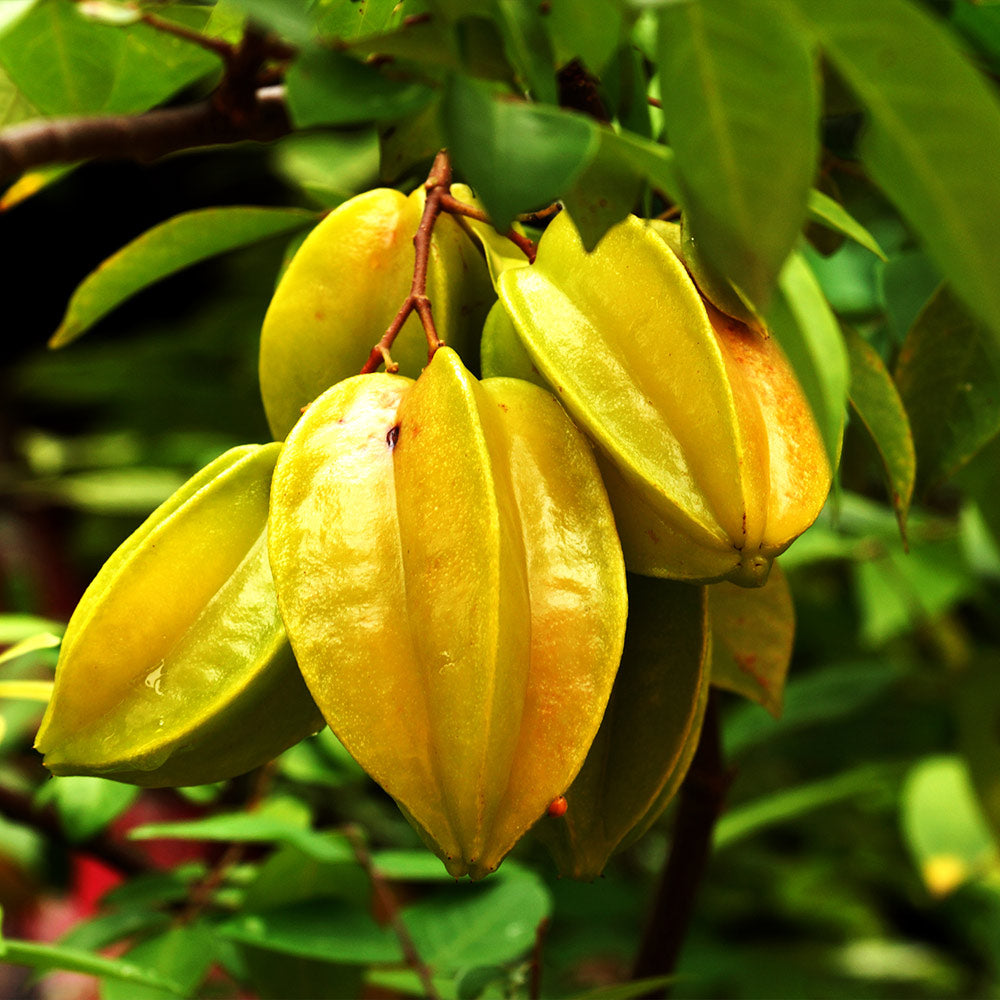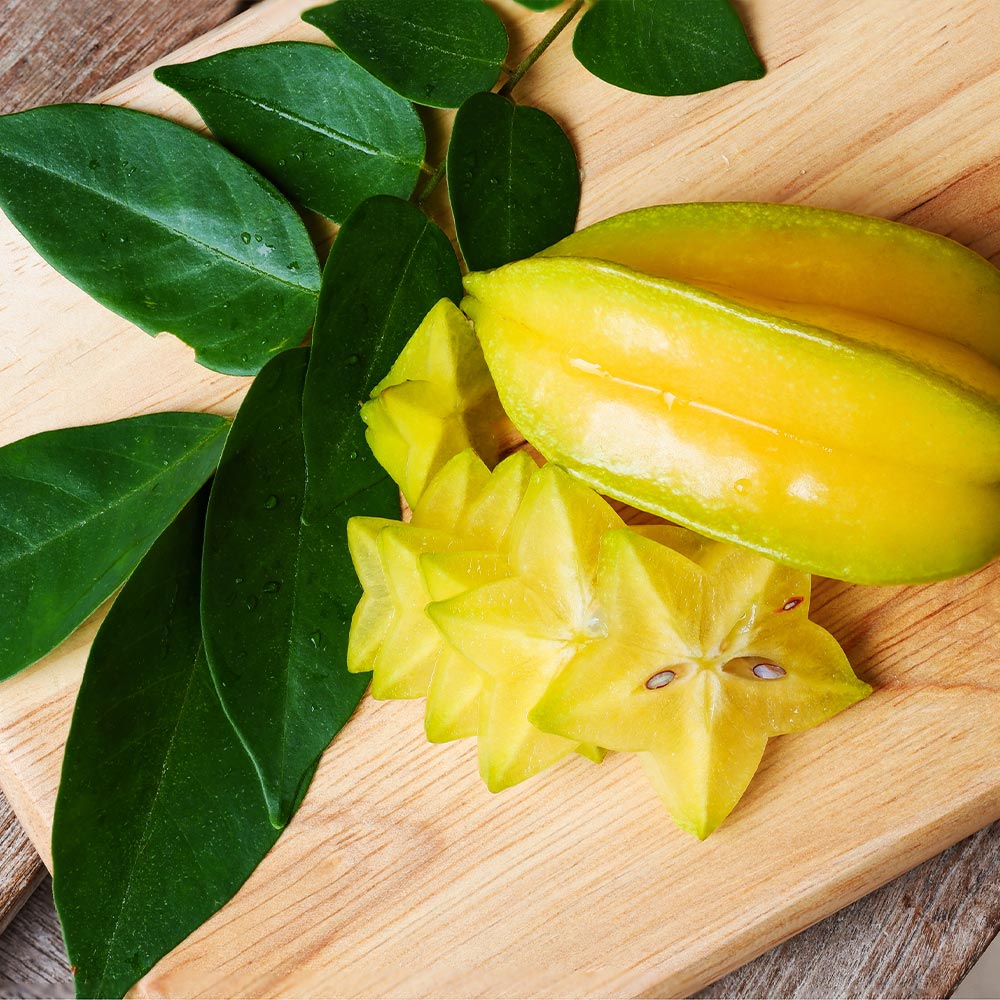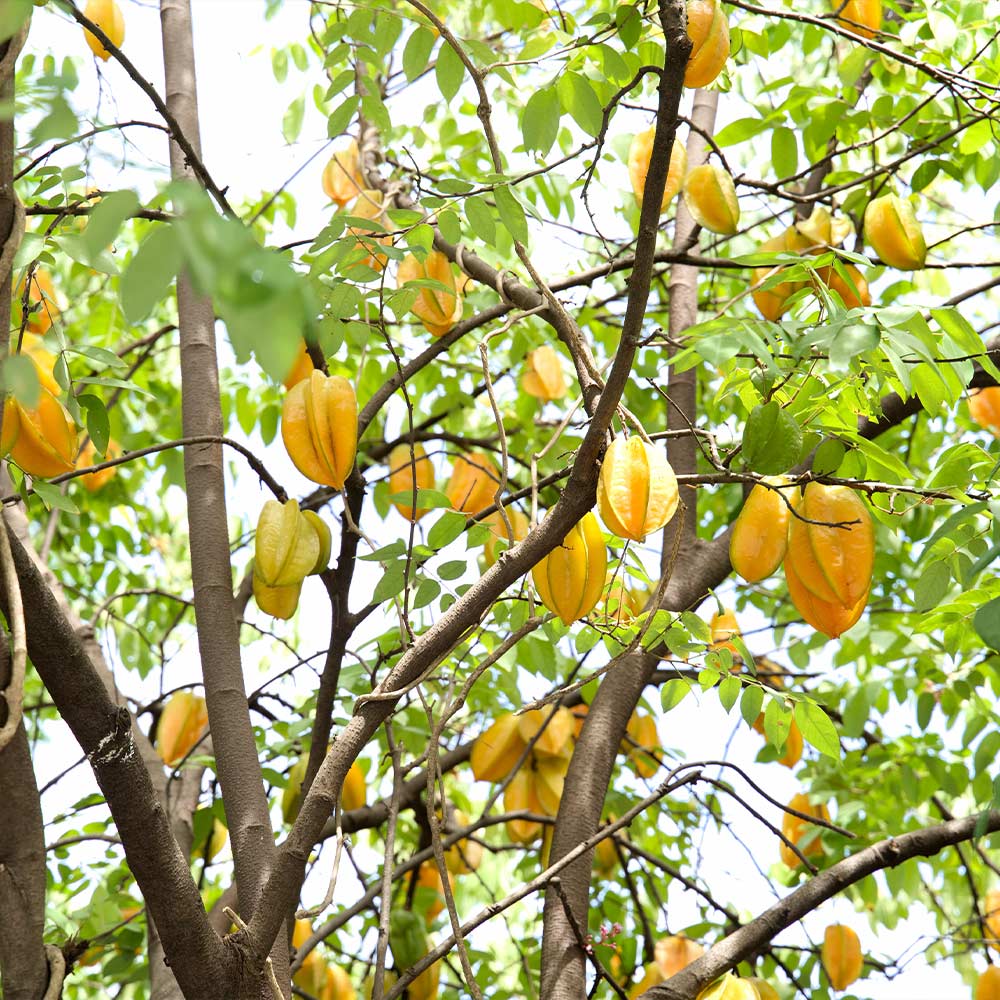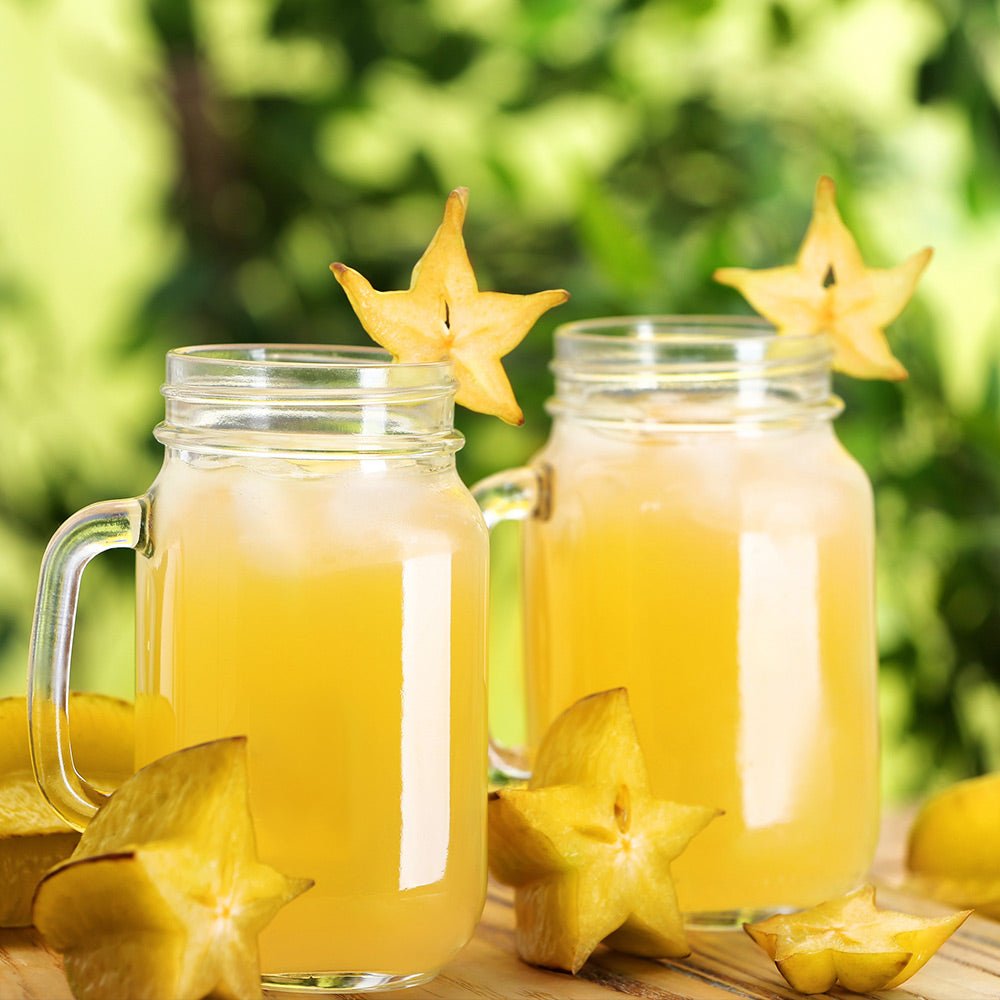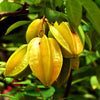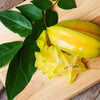* Images shown are of mature plants

Have questions? Talk with our Plant Experts (800) 973-8959
Save 25% on $200+ with code FALL25.
Questions? Call our plant experts: (800) 973-8959
Unique Flavored, Star Shaped Fruit
Here's Why the Star Fruit Tree is a Top Performer:
- Small tree with attractive foliage
- Incredible fruit with distinctive star shape and unique flavor
- Lovely pink and lavender flowers
- Yields high quantities of high quality fruit
A Star is born in your Garden
If you've been searching for a new star among the fruit trees in your garden or landscape, we've found it for you. Introducing the Star Fruit Tree: A compact evergreen that combines a handsome tree with a delicious and unusual fruit. The tree is lush and woody, with delicate lavender flowers that add to the tree's overall beauty. And the fruit itself enhances the overall exotic look.
Its shiny, pale-orange coloring and convex shape appear like numerous sunbursts throughout the tree. The box-like fruit hang like small beacons, adding warmth and charm to any garden or landscape lucky enough to boast this incredible tree.
The Taste is Star Quality
Cut open a fresh, juicy Star Fruit and you'll know right away how it got its name. Cross section slices reveal the unique star shape--a favorite among kids who will love the way it looks as well as the sweet yet faintly sour taste which is unlike any other fruit.
The distinctive flavor has hints of apple, pear, grape and a mild tartness that is all its own. This symphony of flavors makes fruit salads taste fresher and more satisfying than ever before. You can also use Star Fruit as a garnish or even cooked in puddings and stews. With the Star Fruit, the sky's the limit to the meals you will enjoy.
Order yours today.
Pollination Info
Starfruit 'Carambola' Tree Pollination
Starfruit 'Carambola' Trees are self-fertile. You will get fruit with only one plant. However, adding an additional Starfruit 'Carambola' Tree will drastically increase the size of your crop.
Planting & Care
The Starfruit Carambola (Averrhoa carambola) is a small fruit bearing tree with an attractive bushy, evergreen foliage. This fruit has a delicious tangy flavor that resembles an apple, grape, and citrus combination. It’s an incredible fruit with a very distinctive star shape to the fruit as it matures. The starfruit is a fast grower and performs best in USDA growing zones 9-11 outdoors and 4-11 on the patio (potted tree) in full sun. Starfruit trees mature to a height of 20-35 feet tall and 20-25 feet wide.
Location: Choose a location where your starfruit tree is going to get plenty of sunlight, 6-8 hours per day is best. The tree can adapt to any soil type, but grows faster and produces more fruit in a soil with more organic matter. Be sure the area has well draining soil as the tree will not tolerate consistently standing water. These trees will also do better in an area that is protected or sheltered from the wind.
Note: This product grows best in well-draining soil. When you receive your plant, you may notice small, white beads or rocks in the soil - this medium is added to increase drainage and keep your plant happy and healthy!
Planting Instructions (in ground):
1) Dig the hole 3 times the width and slightly shallower than the root ball.
2) Loosen the soil, in and around the hole so the roots can easily break through.
3) Use your fingers to separate the roots of your tree and gently position it down into the hole. The top of the root flare (where the roots end and the trunk begins) should be about an inch above the surrounding soil.
4) Hold the tree straight as you begin to backfill the site, tamping down the soil as you go.
5) Back fill the hole, apply water to settle the soil and remove any air pockets that may have formed.
Planting Instructions (potted): Potted starfruit trees aren’t too picky when it comes to the type of soil they’re grown in. They do tend to grow more quickly and bear a more heavier fruit production in rich loam soils that are moderately acidic (5.5-6.5 pH range).
1) When selecting a container for your starfruit, be sure it has plenty of holes in the bottom as drainage is essential. The pot size should be at least 2 times larger than the pot it initially came in.
2) Fill the container halfway with soil, gently remove the tree from its original pot and position into the new one.
3) Fill in around the tree with the potting soil but but be sure not to cover the grafted area of the tree. Leave about about an inch from the soil surface to the rim of the pot for easy watering.
4) Lightly pack down the soil as you fill and give your tree a deep watering until it flows from the holes in the bottom of the pot. This will settle the soil and eliminate any air pockets that may have formed.
5) Choose a location on the patio, back yard, front/side of the house providing it will receive full sun.
6) If bringing indoors for the winter, keep by a sunny window and water as needed. Also, avoid exposure to both drafts and heat from ventilation.
Watering (in ground): Water your starfruit tree regularly to keep the soil moist. Give it a good deep watering so that it can penetrate into the root system. After watering, allow the top 2-3 inches of the soil to dry out before watering again. Avoid over watering, standing water can lead to root rot. Yellowing, droopy leaves are typically a telltale sign of over watering. Mulching can help retain the soil moisture and also combat competing grasses/weeds.
Watering (potted): Stick your index finger into the soil down to about 2 inches. If there is moisture present, hold off on watering until it feels more dry at that depth. When ready to water, stop once you see it escaping drainage holes at the base of the pot.
Pollination assistance: You can pollinate your indoor trees by hand since most people do not keep a healthy bee population within their home. Simply take a small, fine tipped paint brush and stick it into the center of the blooms. Swirl it around and collect the pollen on the brush. Go to the next bloom and repeat the process until every bloom has been treated. The bloom will fall off naturally and the fruit well begin to form.
Fertilization: Feed your starfruit tree from spring through fall once a month with a well balanced fertilizer like a 10-10-10 or 12-12-12 formula. Be sure to follow the application instructions on the fertilizer.
Pruning: Starfruit trees should be pruned every 1-2 years to maintain a manageable fruiting height. For container grown trees, prune back the out-reaching branches. Pruning should be done in late winter before spring growth starts.
FAQs
Is star fruit hard to grow?
How fast do star fruit trees grow?
Where do star fruit trees grow?
Shipping Details
Estimated Shipping Time: Most orders ship immediately. As noted on the website, some items are seasonal, and may only ship in spring or fall. Once your order is shipped, you'll receive an email with a tracking number.
| Amount of Order | Shipping Charge |
|---|---|
| Less than $49 | $19.95 |
| $49 + | FREE SHIPPING! |
Product Details
| Mature Height: | 20-35 ft. |
| Mature Width: | 20-25 ft. |
| Sunlight: | Full Sun |
| Growth Rate: | Fast Growing |
| Harvest Time: | January-February |
| Botanical Name: | Averrhoa carambola |
| Does Not Ship To: | AK, AZ, HI |
| Grows Well In Zones: | 3-11 patio / 9-11 outdoors |
| Your Growing Zone: | # |

